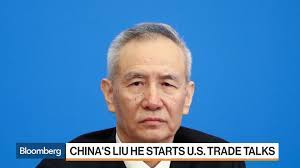The Trump administration expressed optimism it can reach a “reasonable” trade deal with China as President Xi Jinping dispatched one of his top aides to negotiations in Beijing on a lasting truce to a conflict that has roiled financial markets.

“There’s a very good chance that we’ll get a reasonable settlement that China can live with, that we can live with, and that addresses all the key issues,” Commerce Secretary Wilbur Ross told CNBC Monday.
His remarks came hours after a positive development on the ground in Beijing, where Vice Premier Liu He showed up to what were expected to be mid-level talks between U.S. and Chinese officials. Liu has been Xi’s top trade emissary in the dispute with the U.S., which has seen the world’s two biggest economies impose tariffs on a combined $360 billion in each others’ imports.
Economic Cost
Six months since President Donald Trump first slapped tariffs on Chinese goods, signs are growing that the trade war is exacting an economic and financial cost, increasing the incentive for both sides to end the conflict. Apple Inc. cut its revenue outlook last week as sales of the iPhone were slower than expected in China, while data on factory activity and retail sales in the Asian nation were also weak.
Liu’s appearance at the talks is a “symbol of Xi’s personal buy-in” in the effort to reach a deal, said Leland Miller, chief executive officer of China Beige Book, a data-analytics firm that surveys companies across the Chinese economy. “Beijing wants to show this is supported at the very highest level.”
But much work remains before the two economic powers climb down. Trump has given U.S. Trade Representative Robert Lighthizer until March 1 to negotiate an accord with the Chinese on “structural changes” to Beijing’s state-driven economic model. The two sides have shown signs of common ground over the last few months, only for progress to stall.
Thorny Issue
Even if an initial settlement is reached, enforcement will be a thorny issue, Ross said. U.S. officials have complained that China has failed to live up to past promises of reform, including pledges to open up the nation to more imports and foreign investment after it joined the World Trade Organization in 2001.
“An agreement is fine, but the history here has not been so good on compliance,” Ross said. “So the real issue is what are the enforcement mechanisms, what are the punishments if people don’t do what they were supposed to do?”
Talks in Beijing are scheduled to continue through Tuesday, with Lighthizer expected to meet Liu later this month.
The discussions are the first face-to-face interactions between the U.S. and China since both presidents met in Argentina on Dec. 1 and agreed to a temporary truce in their tit-for-tat tariff war. More senior-level discussions could take place this month, with the South China Morning Post reporting that Trump and Chinese Vice President Wang Qishan may meet at the World Economic Forum in Davos, Switzerland.
China’s foreign ministry on Monday confirmed that Wang would deliver a keynote speech at Davos. Lu Kang, a spokesman for the ministry, told reporters he’s unaware of any plans for Wang to meet Trump. He also said he had no further information on this week’s trade talks.
Deputy U.S. Trade Representative Jeffrey Gerrish is leading the American delegation in Beijing. Preliminary discussions were “a little more optimistic than usual,” White House economic adviser Larry Kudlow told Bloomberg TV Friday.









